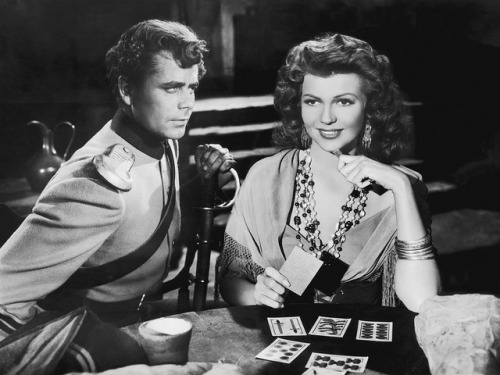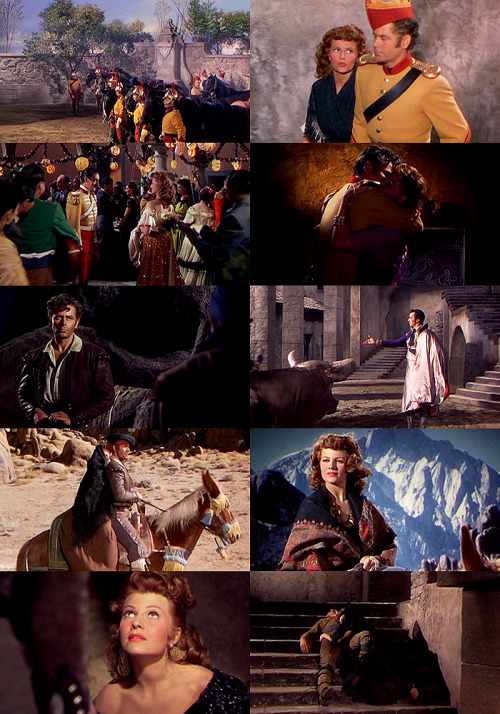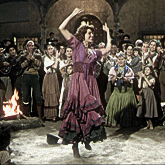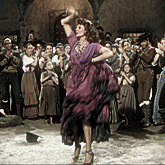Quando falamos sobre Rita Hayworth e
Glenn Ford, pensamos na dupla que protagoniza “Gilda”, de 1946. Mas eles
fizeram outros filmes juntos, incluindo “Carmen”, produzido e dirigido por
Charles Vidor – também diretor de “Gilda” – e filmado num belo Technicolor que
ressaltou a beleza de ambos os astros.
When we talk about Rita Hayworth and Glenn Ford, we
think of the duo in 1946’s Gilda. But they starred together in more movies
together, including “The loves of Carmen”, produced and directed by Charles
Vidor – also the director of Gilda – and shot in ravishing Technicolor that
highlighted both their beauties.
Don Jose (Ford) é um novato vindo de
Navarra. Ele chegou a Andaluzia para ser um soldado da guarda, e a primeira
pessoa que ele conhece em seu primeiro dia é a provocante cigana Carmen
(Hayworth). Assim como todos os ciganos, Carmen é desprezada pelos “cidadãos de
bem” do local.
Don Jose (Ford) is a newcomer from Navarra. He has
arrived in Andalucía in order to serve the guard, and the first person he meets
in his first day is the provocative gypsy Carmen (Hayworth). Like all gypsies,
Carmen is despised by the “good citizens” of the town.
Ela provoca Jose e ele fica caidinho
por ela. Entretanto, ela não aceita o amor dele por causa de uma previsão de má
sorte revelada nas cartas. Mas ela muda de ideia e faz com que Jose mate seu
comandante em um duelo – sendo agora um fora da lei, resta a Jose seguir com
Carmen e um grupo de ladrões rumo às montanhas, onde ele conhece o líder do
grupo, García (Victor Jory), um homem que acaba de sair da prisão... e que por
acaso é marido de Carmen.
She teases Jose and he falls for her. However, she
won’t accept his love because of a bad omen revealed in the cards for her. But
she changes her mind and arranges a duel for Jose to kill his commander - now
an outlaw, Jose can only follow Carmen and her group of thieves to the
mountains, where he meets the group leader, García (Victor Jory), a man who has
just been released from prison... and who happens to be Carmen’s husband.
Antes da fuga, vamos a cidade
espanhola recriada no estúdio sendo fotografada de maneira pouco inspirada, não
tendo nada a ver com outros cenários europeus feitos em estúdio. Esta primeira
metade do filme nos lembra de “Sangue e Areia” (1941), no qual um toureiro
interpretado por Tyrone Power é seduzido por ninguém menos que Rita Hayworth.
Em Hollywood, cidades espanholas e vilas latino-americanas são muito parecidas.
Before they run away, we see the Spanish city recreated
in studio is photographed in an uninspired way, unlike other European sets
built in studio. This first half of the movie reminds us of “Blood and Sand”
(1941), in which a toreador played by Tyrone Power is seduced by none other
than Rita Hayworth. In Hollywood, Spanish towns and Latin American villas are
very much alike.
Na segunda metade, conforme o grupo
foge pelas montanhas, temos a sensação de estarmos assistindo a um faroeste,
com armadilhas, recompensas por um foragido, tropas perseguindo o grupo e
muitos tiros disparados. Jose trocou de lado completamente e agora está
roubando carruagens e se tornando mais violento a cada dia – não porque ele queira,
mas porque precisa.
In the second half, as the group escapes through
the mountains, we get the feeling that we are now watching a western, with
traps, rewards for an outlaw, troops coming for our group and a lot of
shootings. Jose traded places completely and is now stealing from stagecoaches
and becoming more violent each day- not because he wants to, but because he has
to.
É uma delícia ver Rita Hayworth
cantando e dançando músicas folclóricas neste filme. Quando garota, sob seu
nome verdadeiro, Rita Cansino, ela dançava profissionalmente, em uma dupla com
o pai, Eduardo Cansino, que inclusive trabalhou em “Carmen” como coreógrafo.
Ela dançava coreografias como as do filme desde pequena. O único ponto negativo
é que ela é dublada ao cantar. A voz dela é dublada por Anita Ellis, que também
a dublou em “Gilda”.
It’s delightful to see Rita Hayworth singing and
dancing folk songs in this film. As a young girl, under her real name Rita
Cansino, she danced for a living, making a duo with her father, Eduardo, who
even worked here in “The loves of Carmen” as a choreographer. She had been
performing dances like the ones in the film since a very early age. The only
downside is that she is dubbed in the songs. Her singing voice is dubbed by
Anita Ellis, who also dubbed her in “Gilda”.
Para o povo, Carmen é nojenta. Para a
elite, ela é fonte de entretenimento, pois dança nas festas. Isso significa que
ela é uma curiosidade para a sociedade, e nada mais. É um comportamento bem
hipócrita. Carmen não é apenas uma excluída porque faz parte de um grupo nômade
– os ciganos – ela também é vítima de preconceito porque é uma mulher livre que
não pode “pertencer” a um homem só.
For the people, Carmen is disgusting. For the
elite, she is source of entertainment when she dances at parties. That means
that she is a curiosity for society, and nothing else. It’s a very hypocritical
behavior. Not only Carmen is an outcast because she is part of a nomad group –
the gypsies – she is also frown upon because she is a free woman that can’t “belong”
to one man.
Um texto inicial cheio de
preconceitos, chamando os ciganos de “uma raça infeliz”, mostra o pensamento
que foi responsável pela perseguição de milhões de ciganos durante o Holocausto
– ou melhor, o “Porajmos”. Sim, os ciganos rom têm seu próprio termo para a
perseguição que sofreram dos nazistas – não há números oficiais, alguns
historiadores estimam que 200 mil ciganos foram mortos em campos de
concentração, e outros colocam a estimativa em 1,5 milhão. Hollywood não estava
fazendo um favor a estas pessoas três anos após a queda de Hitler com tanto
preconceito.
An opening text full of prejudice, calling the
gypsies “an unhappy breed”, shows the mindset that was responsible for the
persecution of millions of gypsies during the Holocaust – or better, the “Porajmos”.
Yes, the Romani gypsies have their own word for the persecution they suffered
under the Nazis – there are no official numbers, some historians estimate
200000 gypsies were killed in concentration camps, and other put the number up
to 1,5 million. Hollywood wasn’t doing a favor to those people three years
after Hitler’s fall with so much prejudice.
Se refletirmos um pouco, “Carmen” tem
algumas coisas em comum com “Gilda”: a protagonista sedutora, o protagonista que
é bobo no começo mas fica mais durão e ciumento por causa de uma mulher, muitas
traições, o fatalismo que paira sempre no ar. “Carmen” só se difere por causa
do cenário e do Technicolor, os elementos da história são os mesmos. Eu não
estou falando que “Carmen” é um filme noir: eu estou dizendo que as histórias
do noir bebem de uma fonte universal.
If we think a little, “The loves of Carmen” has
some things in common with “Gilda”: the seductive leading lady, the leading man
who is at first silly then becomes tougher and more jealous because of a woman,
the many betrayals, and the fatalism that is all over. “The loves of Carmen” is
different only for its setting and the Technicolor, the story elements are the
same. I’m not saying that this film is noir: I’m saying that the noir stories drink
from a universal fountain.
“Carmen” certamente se beneficia da
química entre os protagonistas. Entretanto, não é tão interessante quanto
outras versões da mesma história, como “Carmen Jones”, de 1954. Mas pelo menos
podemos ver Glenn Ford mais bonito que nunca e Rita Hayworth dançando danças
espanholas.
“The loves of Carmen” certainly profits from the
chemistry the two leads have. However, it’s not as interesting as other
versions of the same story, like “Carmen Jones”, from 1954. But at least we are
able to see Glenn Ford more handsome than ever and Rita Hayworth dancing
Spanish songs.
This is my contribution to the 100 Years of Rita Hayworth blogathon, hosted by Michaela at Love Letters to Old Hollywood.











5 comments:
Very interesting. I haven't seen this movie yet, but it sounds like it will be a feast for the eyes.
I always consider "Carmen" in all its versions quite noirish. A fellow falls for a dame who leads him down the garden path. In each version, my heart goes out to the freedom loving gypsy.
I've had this movie recorded for almost a year now, but because I haven't read a lot of good things about it, I've been putting off seeing it. Your post, however, has really inspired me to watch it this weekend. Just looking at the pictures and gifs you had was enough to convince me -- wow!
Thanks so much for contributing to my blogathon, and I'm so sorry again for missing your submission!
Hi Le — I agree that Rita returns to her roots, performing those Latin dances and songs with her usual fabulous passionate style, but I wish the movie overall was better. Quite a letdown after the splendors of Gilda...and Glenn Ford Who was so appealing there is not very effective here. Script is below par, too, in my opinion, but Rita is beautiful in Technicolor!
- Chris
Achei o filme interessante pela presença dois atores principais. Rita ta deslumbrante dançado
BELíSSiMO FiLME! ...De fato a lindíssima Carmen (Rita Hayworth), era uma mulher a frente do seu tempo, sofria preconceitos, era desprezada pelos hipócritas, porém, se defendia com astúcia pra sobreviver... Cuspia em honras nódoas, foi esculpida pelo meio que nasceu e viveu. Razão pela qual,
achei injusto seu fim cruel.
Post a Comment